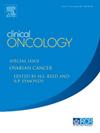vmat驱动的点阵放疗在大肿瘤跨解剖部位的优化和质量保证
IF 3
3区 医学
Q2 ONCOLOGY
引用次数: 0
摘要
目的:本研究探讨了使用TrueBeam STx(Varian Medical Systems)对头颈部、胸部和腹部肿瘤进行基于vmat的点阵放疗(LRT)的可行性、剂量学优化和验证。材料与方法入选肿瘤总体积(gtv)≥550 cc、格点≥10个的患者60例。使用西门子Somatom go.Sim获取计划ct。在Eclipse (v15.1)中使用HD120 mlc生成6 MV FFF波束的VMAT图。每个球形高剂量顶点分5次接受20 Gy。优化采用同心剂量环(C1-C3)进行谷剂量控制。评估的剂量学参数包括D95%、Dmean、D50%、均匀性指数(HI)和峰谷剂量比(PVDR)。在Rando幻影和ArcCHECK伽马分析(3%/3 mm)中使用osld进行验证。结果腹部肿瘤表现出最高的空间调节,轴向VPDR达到0.62,而头颈部和胸部的VPDR为0.47。腹部球体剂量的标准差最低(Dmean = 2113.8±47.1 cGy)。头部和颈部病例需要更高的调制强度(MU/度= 3.8),因为桨叶接近,而腹部病例需要降低龙门架速度(1.2°/秒),以获得更大的剂量梯度。所有站点的伽马通过率超过96%,确认了交付的准确性。结论vmat引导下的LRT对大肿瘤具有稳定的峰谷剂量调制和可重复的高剂量顶点递送。解剖位置显著影响顶点几何形状、调制要求和剂量学结果。腹部平面图表现出优越的均匀性和空间分隔,而头颈部病例则需要更复杂的优化。标准化的计划方案和严格的质量保证对于LRT的安全临床翻译至关重要。本文章由计算机程序翻译,如有差异,请以英文原文为准。
Optimization and Quality Assurance of VMAT-Driven Lattice Radiotherapy in Large Tumors Across Anatomical Sites
Aims
This study investigates the feasibility, dosimetric optimization, and validation of VMAT-based Lattice Radiotherapy (LRT) across head and neck, thoracic, and abdominal tumors using TrueBeam STx(Varian Medical Systems).
Materials and methods
60 patients with gross tumor volumes (GTVs) >550 cc and ≥10 lattice vertices were included. Planning CTs were acquired using a Siemens Somatom go.Sim. VMAT plans were generated in Eclipse (v15.1) with 6 MV FFF beams, using HD120 MLCs. Each spherical high-dose vertex received 20 Gy in 5 fractions. Optimization incorporated concentric dose rings (C1–C3) for valley dose control. Dosimetric parameters evaluated included D95%, Dmean, D50%, Homogeneity Index (HI), and Peak-to-Valley Dose Ratio (PVDR). Validation was performed using OSLDs in a Rando phantom and ArcCHECK gamma analysis (3%/3 mm).
Results
Abdominal tumors showed the highest spatial modulation, with axial VPDR reaching 0.62, compared to 0.47 in head and neck and thoracic sites. Abdominal sphere doses exhibited the lowest standard deviation (Dmean = 2113.8 ± 47.1 cGy). Head and neck cases required higher modulation intensity (MU/deg = 3.8) due to OAR proximity, while abdominal cases required reduced gantry speeds (1.2°/sec) for sharper dose gradients. Gamma pass rates exceeded 96% across all sites, confirming delivery accuracy.
Conclusion
VMAT-guided LRT provides robust peak-to-valley dose modulation and reproducible high-dose vertex delivery for large tumors. Anatomical location significantly affects vertex geometry, modulation requirements, and dosimetric outcomes. Abdominal plans demonstrated superior uniformity and spatial separation, whereas head and neck cases demanded more complex optimization. Standardized planning protocols and rigorous QA are essential for safe clinical translation of LRT.
求助全文
通过发布文献求助,成功后即可免费获取论文全文。
去求助
来源期刊

Clinical oncology
医学-肿瘤学
CiteScore
5.20
自引率
8.80%
发文量
332
审稿时长
40 days
期刊介绍:
Clinical Oncology is an International cancer journal covering all aspects of the clinical management of cancer patients, reflecting a multidisciplinary approach to therapy. Papers, editorials and reviews are published on all types of malignant disease embracing, pathology, diagnosis and treatment, including radiotherapy, chemotherapy, surgery, combined modality treatment and palliative care. Research and review papers covering epidemiology, radiobiology, radiation physics, tumour biology, and immunology are also published, together with letters to the editor, case reports and book reviews.
 求助内容:
求助内容: 应助结果提醒方式:
应助结果提醒方式:


